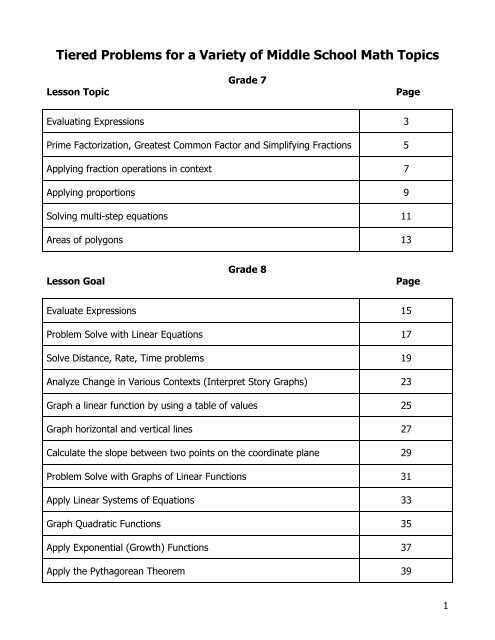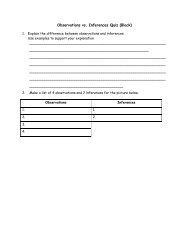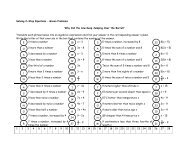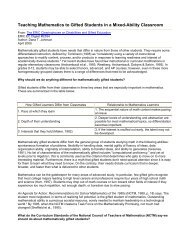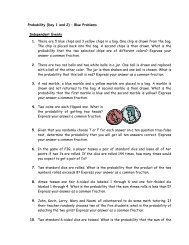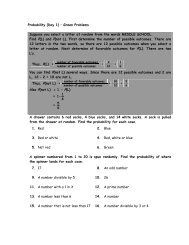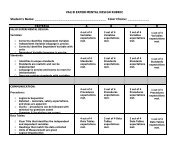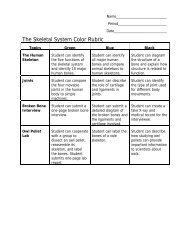Tiered Problems for a Variety of Middle School ... - WordPress.com
Tiered Problems for a Variety of Middle School ... - WordPress.com
Tiered Problems for a Variety of Middle School ... - WordPress.com
Create successful ePaper yourself
Turn your PDF publications into a flip-book with our unique Google optimized e-Paper software.
<strong>Tiered</strong> <strong>Problems</strong> <strong>for</strong> a <strong>Variety</strong> <strong>of</strong> <strong>Middle</strong> <strong>School</strong> Math Topics<br />
Lesson Topic<br />
Grade 7<br />
Page<br />
Evaluating Expressions 3<br />
Prime Factorization, Greatest Common Factor and Simplifying Fractions 5<br />
Applying fraction operations in context 7<br />
Applying proportions 9<br />
Solving multi-step equations 11<br />
Areas <strong>of</strong> polygons 13<br />
Lesson Goal<br />
Grade 8<br />
Page<br />
Evaluate Expressions 15<br />
Problem Solve with Linear Equations 17<br />
Solve Distance, Rate, Time problems 19<br />
Analyze Change in Various Contexts (Interpret Story Graphs) 23<br />
Graph a linear function by using a table <strong>of</strong> values 25<br />
Graph horizontal and vertical lines 27<br />
Calculate the slope between two points on the coordinate plane 29<br />
Problem Solve with Graphs <strong>of</strong> Linear Functions 31<br />
Apply Linear Systems <strong>of</strong> Equations 33<br />
Graph Quadratic Functions 35<br />
Apply Exponential (Growth) Functions 37<br />
Apply the Pythagorean Theorem 39<br />
1
7 th Grade Unit: Algebraic Expression and Integers<br />
Lesson: Evaluating Expressions<br />
Goal: Students evaluate variable expressions by substitution and solve word problems<br />
by evaluating expressions.<br />
Green level problems:<br />
c<br />
1. Evaluate 3ab ! <strong>for</strong> a " 2 , b " 5 , and c " 10<br />
2<br />
2. Write an expression <strong>for</strong> the number <strong>of</strong> kilometers a dolphin travels in h hours<br />
swimming at 8 km/hr. Then find the number <strong>of</strong> kilometers the dolphin travels in 3<br />
hours.<br />
Blue Level <strong>Problems</strong>:<br />
3. If a = 4.9 and b = 1 9<br />
5 , determine the value <strong>of</strong> the reciprocal <strong>of</strong> b/a.<br />
Express your answer as a <strong>com</strong>mon fraction.<br />
4. The cost <strong>of</strong> rope at hardware store depends on its length in feet and its price per foot.<br />
Write a variable expression using 4 variables to represent the cost <strong>of</strong> 2 ropes that have<br />
different lengths and price per foot. Explain what each variable represents. Use the expression<br />
to evaluate the total cost to buy a 28-foot rope at $.23 per foot and a 36-foot rope at $.39 per<br />
foot.<br />
Black Level <strong>Problems</strong>:<br />
5. Heron’s <strong>for</strong>mula (sometimes called the semi-perimeter <strong>for</strong>mula) says that if a triangle has<br />
sides lengths a, b, and c, then the area <strong>of</strong> the triangle is given by<br />
(a<br />
A = s (s - a)(s - b)(s - c) where s<br />
+ b + c)<br />
=<br />
. As a decimal to the nearest tenth, how many<br />
2<br />
square inches are in the area <strong>of</strong> the triangle with sides <strong>of</strong> length 4, 5, and 6 inches?<br />
6. Shark Problem. A shark takes 20 minutes to swim with the current from its cave to the<br />
feeding grounds. Later, it returns against the current, taking 30 minutes.<br />
a. Define variables <strong>for</strong> the shark’s speed through the water and <strong>for</strong> the speed <strong>of</strong> the current<br />
(the speed at which the water is moving). Use feet per minute (ft/min). Then write two<br />
expressions, one <strong>for</strong> the distance the sharks swims out and the other <strong>for</strong> the distance it<br />
swims back.<br />
b. Evaluate the expression in part (a) if:<br />
i. The shark swims 400 ft/min and the current is 100 ft/min;<br />
ii. The shark swims 80 ft/min and the current is 50 ft/min.<br />
3
Solutions are provided here <strong>for</strong> the Blue and Black problems:<br />
Blue Solutions<br />
3. The reciprocal <strong>of</strong> a<br />
b is b<br />
a , so let’s just find b<br />
a :<br />
1 9<br />
5<br />
49<br />
4.9 =<br />
10<br />
14<br />
9<br />
=<br />
49 x<br />
9 = 63 .<br />
10 14 20<br />
4. Sample answer : p!"+ cf , where p is the cost per foot, !"is the length in feet <strong>of</strong> one rope and<br />
c is the cost per foot and f is the length in feet <strong>of</strong> the other rope ; $20.48<br />
Black Solutions<br />
5. First, we calculate s, which is the semi-perimeter. s =<br />
Using this value and the three side lengths in the <strong>for</strong>mula, we get<br />
A= 7.5(7.5-4)(7.5-5)(7.5-6) = 98.4375 ! 9.9 square inches.<br />
4 + 5 + 6 = 7.5.<br />
2<br />
6. a. 20 (x + y) = no. <strong>of</strong> ft out, 30 (x – y) = no. <strong>of</strong> ft back<br />
b. i. 10000 ft out, 9000 ft back<br />
ii. 2600 ft out, 900 ft back<br />
c. Shark swims 87.5 ft/min.<br />
4
7th Grade Unit: Factors Fractions and Exponents<br />
Lesson: Prime Factorization, Greatest Common Factor and Simplifying Fractions<br />
! Goals: Students learn to find the prime factorization <strong>of</strong> a number, the greatest <strong>com</strong>mon factor<br />
(GCF) <strong>of</strong> two or more numbers, to find equivalent fractions and to write fractions in simplest <strong>for</strong>m.<br />
Green level problems:<br />
1. Use prime factorization to find the GCF <strong>of</strong><br />
2 3 2<br />
27 x y ,46x y<br />
2. Write in simplest <strong>for</strong>m:<br />
2<br />
x y<br />
3yz<br />
Blue Level <strong>Problems</strong>:<br />
3. What is the sum <strong>of</strong> the three distinct prime factors <strong>of</strong> 47,432?<br />
4. In a certain code, each <strong>of</strong> the 26 letters <strong>of</strong> the English alphabet is represented by a number<br />
(A=1, B=2, C=3,... Z=26). A word is then encoded by multiplying the numbers that represent its<br />
letters. For example, CAT is encoded by 3* 1* 20 = 60, MATH is encoded by 13*1*20*8 = 2080.<br />
Find a word that would be encoded as 7560 and explain how you found it. Could there be other<br />
words? Explain why or why not.<br />
Black Level <strong>Problems</strong>:<br />
5. What is the least whole number value <strong>of</strong> x such that f(x) = x 2 + x + 11 is not prime?<br />
6. A natural number n, such that n > 1, can’t be written as the sum <strong>of</strong> two more consecutive odd<br />
numbers if and only if n is prime or n is twice an odd number. Of the ten natural numbers 20 through<br />
29, how many can’t be written as the sum <strong>of</strong> two or more consecutive odd numbers?<br />
5
Solutions are provided here <strong>for</strong> the Blue and Black problems:<br />
Blue Solutions<br />
3. The prime factorization <strong>of</strong> 47,432 is 2 3 x7 2 x11 2 . The sum <strong>of</strong> the three prime factors is 2 + 7 + 11 =<br />
20.<br />
4. LINE, ALIEN, REGAL, BORN, LARGE, BARON are only some <strong>of</strong> the many.<br />
We began to solve the equation by making a factor tree. We factored the number 7560 until we<br />
received four numbers that translated into letters, which we <strong>for</strong>med into a real word. This is an<br />
example <strong>of</strong> our factor tree:<br />
7560<br />
/ \<br />
20 378<br />
/\ / \<br />
Numbers used: 4 5 18 21<br />
Translation <strong>of</strong> numbers: D E R U<br />
Letters unscrambled: R U D E<br />
Black Solutions<br />
5. Value <strong>of</strong> the function can be checked with a chart.<br />
x x 2 + x + 11<br />
0<br />
1<br />
2<br />
3<br />
4<br />
.<br />
.<br />
.<br />
10<br />
11<br />
13<br />
17<br />
23<br />
31<br />
.<br />
.<br />
.<br />
121<br />
When x = 10, the value <strong>of</strong> the function is x 2 + x + 11 = 10 2 + 10 + 11 = 121. This is the first value <strong>of</strong> the<br />
function which is not prime, so the answer is 11.<br />
6. The primes from 20 to 29 are 23 and 29. The numbers that are twice an odd number are 22 and 26. These 4<br />
natural numbers can’t be written as the sum <strong>of</strong> two or more consecutive odd numbers.<br />
6
7 th Grade Unit: Operations with Fractions<br />
Lesson: “Combo Day”<br />
Goal: Students are able to identify which operation is needed to solve a problem. They<br />
can multiply, divide, add and subtract fractions.<br />
Green level problems:<br />
1. How many ¾ inch-long beads are needed to make a 12-inch long necklace?<br />
2. You and a friend make a bet. He bets that he is more than 5 inches taller than you. You bet that he<br />
16<br />
5<br />
7<br />
is not. If you are 5 ft. 5 inches tall and he is 5 ft. 5 inches tall, who won the bet?<br />
8 16<br />
Blue Level <strong>Problems</strong>:<br />
3. Ann gave 4<br />
1 <strong>of</strong> her beads to Joey, 16<br />
3 <strong>of</strong> them to May and 5<br />
1 <strong>of</strong> the rest to Rose. If Ann had 36 beads<br />
left, how many beads did she have at first?<br />
4.<br />
2 in.<br />
3<br />
5 2 in. 3 The figure is <strong>com</strong>posed <strong>of</strong> a triangle and a rectangle. The area <strong>of</strong><br />
the figure is 24 square inches. Find the value <strong>of</strong> x .<br />
2 in.<br />
0 1 2 3 4<br />
x in.<br />
Black Level <strong>Problems</strong>:<br />
5. The Density Property. The diagram shows a number line. Between 3 and 4 there are many other<br />
numbers such as 3.5, 3.79, 3.22861154. . . , etc. If a set <strong>of</strong> numbers has the property that between any<br />
two <strong>of</strong> them there is another number <strong>of</strong> that kind, then the set <strong>of</strong> numbers is said to be dense. The work<br />
you have been doing with fractions allows you to tell whether or not certain sets <strong>of</strong> numbers are dense.<br />
There are real numbers between 3 and 4.<br />
Answer the following questions.<br />
a. Find a real number between 4.8 and 4.9.<br />
b. Find five real numbers between 7.83 and 7.84.<br />
2x<br />
# 11 3<br />
6. !<br />
2<br />
x # 7x ! 12 ( x # 4)<br />
:<br />
:<br />
:<br />
0 1 2 3 4<br />
7
Solutions are provided here <strong>for</strong> the Blue and Black problems:<br />
Blue Solutions:<br />
3.<br />
1<br />
4<br />
3<br />
16<br />
?<br />
1<br />
5<br />
36<br />
After giving part <strong>of</strong> her beads to Joey and May, fraction <strong>of</strong> Ann’s beads left<br />
=1 -<br />
1 -<br />
3 =<br />
16 -<br />
4 -<br />
3 =<br />
9<br />
4 16 16 16 16 16<br />
After giving part <strong>of</strong> her beads to Rose, fraction <strong>of</strong> Ann’s beads left<br />
Number <strong>of</strong> beads Ann had at first=<br />
9<br />
36 + 20<br />
20<br />
" 36& " 80<br />
9<br />
She had 80 beads at first.<br />
$ 1 % 9 4 9 9<br />
' 1# (& " & "<br />
) 5 * 16 5 16 20<br />
4. x = 4<br />
Black Solutions:<br />
5. a) Answers may vary. 4.85 b. Answers may vary. 7.831, 7.833, 7.835<br />
6.<br />
5<br />
x # 3<br />
8
7 th Grade Unit: Ratios, Proportions, Percents and Probability<br />
Lesson: Proportions<br />
Goals: Students extend their work with ratios to develop an understanding <strong>of</strong><br />
proportionality and they use proportions to solve problems.<br />
Students use proportions to make estimates relating to a population on the basis <strong>of</strong> a<br />
sample.<br />
Green level problems:<br />
1. The distance traveled by a bus at a constant speed is directly proportional to the<br />
length <strong>of</strong> time it travels. If a bus travels 320 km in 4 h, how far will it travel in 9h?<br />
2. Of 75 pairs <strong>of</strong> jeans, 7 have flaws. Estimate how many <strong>of</strong> 24,000 pairs <strong>of</strong> jeans are<br />
flawed.<br />
Blue Level <strong>Problems</strong>:<br />
3. A 12-foot board is cut into three pieces whose<br />
lengths are in the ratio 3:1:2. How many inches are in<br />
the length <strong>of</strong> the shortest piece?<br />
4. Solve the following proportion <strong>for</strong> x:<br />
3x -2 =<br />
x + 4 _____<br />
4 2<br />
Black Level <strong>Problems</strong>:<br />
5. A wheel rotates once a second. Object two (O) is twice the distance from the center<br />
<strong>of</strong> the wheel as object one (O 1 ). How fast is O moving in <strong>com</strong>parison to O 1 ?<br />
6. Three miners can load 350 pounds <strong>of</strong> coal in 15 minutes. How many minutes would it take two<br />
miners to load 700 pounds <strong>of</strong> coal?<br />
9
Solutions are provided here <strong>for</strong> the Blue and Black problems:<br />
Blue Solutions:<br />
3. The three pieces are in ratio 3:1:2. Since 3 + 1 + 2 = 6, then a 6-foot board would be<br />
cut into pieces that were 3, 1, and 2 feet, respectively. Since the board you are given is<br />
12 feet, or twice as long, the piece should each be twice as long, and the smallest piece<br />
will be 2 feet.<br />
Since the question asks <strong>for</strong> the number <strong>of</strong> inches in the smallest piece, the 2 feet must<br />
be converted to inches: 2 feet x 12 inches/foot = 24 inches.<br />
4. 10<br />
Black Solutions:<br />
5. Let x be the distance from the center<br />
<strong>of</strong> the wheel O 1 . In one second O 1 goes a<br />
distance 2!x. The distance O goes in the<br />
same second is 2"(2x) or twice the<br />
distance O 1 goes. Hence, O goes twice the<br />
speed <strong>of</strong> O 1 .<br />
x<br />
2x<br />
O 1 O<br />
6. If three miners can load 350 pounds in 15 minutes, then three miners can load<br />
2 • 350 = 700 pounds in 2 • 15 = 30 minutes. Then, 1 miner can load 700 pounds in<br />
3 • 30 = 90 minutes, and 2 • 1 = 2 miners can load 700 pounds in 90 ÷ 2 = 45<br />
minutes. Remember, double the number <strong>of</strong> miners can load double the number <strong>of</strong><br />
pounds in the same time, or double the number <strong>of</strong> miners can load the same<br />
number <strong>of</strong> pounds in half the time.<br />
10
7 th Grade Unit: Solving Multi-Step Equations<br />
Lesson: Solving Multi-Step Equations<br />
Goals: Students <strong>com</strong>bine like terms and use the distributive property to simplify and<br />
then solve multi-step equations.<br />
Students apply these skills to consecutive integer word problems<br />
Green level problems:<br />
1. Solve. Check your solution. 16 " 2( x # 1) # x<br />
2. The sum <strong>of</strong> three consecutive integers is 96. Find the integers.<br />
Blue Level <strong>Problems</strong>:<br />
3. The sum on an odd integer and twice its consecutive is equal to equal 3757. Find the number.<br />
4. Membership Boom. There was a surge in math club membership after the fun<br />
Halloween party. When the principal asked Mrs. Germain how many students were<br />
currently in the club, she replied, “Three times our number plus a third <strong>of</strong> our<br />
number plus a fourth <strong>of</strong> our number plus you and me is two hundred sixty.”<br />
The principal smiled and nodded, then added, “If you can pick up another eight<br />
students be<strong>for</strong>e your Christmas party you will have exactly 10% <strong>of</strong> the student<br />
body involved in the club.”<br />
a. How many students are enrolled in the math club?<br />
b. How many students are in the school?<br />
Black Level <strong>Problems</strong>:<br />
5. Solve <strong>for</strong> a in terms <strong>of</strong> b if two more than twice a is three less than the square <strong>of</strong> the<br />
number which is one less than b.<br />
6. The units <strong>of</strong> a two-digit number is 40% <strong>of</strong> the tens digit. If the digits are reversed,<br />
the resulting number is 27 less than the original number. Find the original number.<br />
11
Solutions are provided here <strong>for</strong> the Blue and Black problems:<br />
Blue Solutions:<br />
3. The difference between two odd integers is equal to 2. let x be an odd integer and x + 2 be<br />
its consecutive. The sum <strong>of</strong> x and twice its consecutive is equal to 3757 gives an equation <strong>of</strong> the<br />
<strong>for</strong>m<br />
x + 2(x + 2) = 3757<br />
Solve <strong>for</strong> x x = 1251<br />
Check that the sum <strong>of</strong> 1251 and 2(1251 + 2) is equal to 3757.<br />
4. Let n = the number <strong>of</strong> students in the math club.<br />
3n +<br />
1 n +<br />
1 n + 2 = 260<br />
3 4<br />
3<br />
7 n + 2 = 260<br />
12<br />
3<br />
7 n = 258 12<br />
n = 72<br />
Then, if the 72 math club students gain 8 more members be<strong>for</strong>e the Christmas pageant<br />
they would have a total <strong>of</strong> 80 members in the Math Club, and 10% <strong>of</strong> the schools students,<br />
also. 72 + 8 = 80 members.<br />
Black Solutions:<br />
5.<br />
Translating the English into algebra, we get the following equation: 2a + 2 = , b # 1- 2<br />
# 3. Solving <strong>for</strong><br />
a in terms <strong>of</strong> b, we get 2a + 2 = (b 2 - 2b + 1) - 3, then 2a = b 2 - 2b – 4, and finally a =<br />
b 2 -2b - 4<br />
2<br />
6. 52<br />
12
7 th Grade Unit: Area and Volume:<br />
Lesson: Area <strong>of</strong> Polygons<br />
Goal: Students understand and apply area <strong>for</strong>mulas <strong>for</strong> polygons. Students de<strong>com</strong>pose<br />
irregular two dimensional shapes into smaller <strong>com</strong>ponent shapes.<br />
Green level problems:<br />
1. An architect has the option <strong>of</strong> the two rooms shown <strong>for</strong> a new hotel. Which room would<br />
provide the most space <strong>for</strong> the guests?<br />
5 ft<br />
4 ft<br />
4 ft<br />
10.5 ft<br />
6 ft<br />
7 ft<br />
12 ft<br />
10 ft<br />
2. Ken and Kathy went horseback riding at noon. Ken rode north at 3 km per hour and Kathy<br />
rode west at 3.5 km per hour. How far apart were they at 2 P.M.? Round to the nearest<br />
kilometer.<br />
Blue Level <strong>Problems</strong>:<br />
3. Change in Area. The length <strong>of</strong> a rectangle is increased by 20 percent, and its width is<br />
decreased by 10 percent. By what percent does the area <strong>of</strong> the rectangle change? What if,<br />
instead, we decreased the length by 20 percent and increased the width by 10 percent?<br />
4. A square blanket measuring x feet by x feet was folded in half, folded in half again and<br />
finally folded in half one last time. After these three successive folds, without ever unfolding,<br />
the blanket covers an area <strong>of</strong> 8 square feet. What is the value <strong>of</strong> x?<br />
Black Level <strong>Problems</strong>:<br />
5. The ratio <strong>of</strong> the length <strong>of</strong> the base to the length <strong>of</strong> the height <strong>of</strong> the triangle is 2 : 3. The<br />
area <strong>of</strong> the triangle is 81 square centimeters. What is the number <strong>of</strong> centimeters in the height<br />
<strong>of</strong> the triangle? Express your answer in simplest radical <strong>for</strong>m.<br />
6. Find the area <strong>of</strong> a regular octagon with side 20 and apothem 10<br />
:<br />
a = 10<br />
13
Solutions are provided here <strong>for</strong> the Blue and Black problems:<br />
Blue Solutions:<br />
3. Change in Area.<br />
Eight percent increase in the first case and 12 percent decrease in the second case. Let L<br />
represent the length and W represent the width, so LW represents the area. If L is increased<br />
by 20 percent, it be<strong>com</strong>es 1.2L. If W is decreased by 10 percent, it be<strong>com</strong>es 0.9W. The area <strong>of</strong><br />
the new rectangle is (1.2L)(0.9W) = 1.08 LW, which is an 8 percent increase over the original<br />
LW. In the second case, we have a new area <strong>of</strong> (0.8L)(1.1W) = 0.88 LW, which accounts <strong>for</strong> a 12<br />
percent decrease from LW.<br />
4. If 8 square feet is half <strong>of</strong> half <strong>of</strong> half <strong>of</strong> the area <strong>of</strong> the blanket, then the area <strong>of</strong> the<br />
blanket is 8 x 2 x 2 x 2 = 64 square feet. The side length x, must be square root <strong>of</strong> 64, which is<br />
8 feet.<br />
Black Solutions:<br />
5. Given the ratio 2 : 3, we can write the base as two times as unknown value x and the height as<br />
three times the same unknown value x. The area <strong>for</strong>mula <strong>for</strong> a triangle is A =<br />
1 bh. We know the<br />
2<br />
area and can write the height and base in terms <strong>of</strong> x. This gives us: 81 =<br />
1 (2x)(3x), which<br />
2<br />
simplifies to 81=3x 2 . Dividing both sides by 3, we get 27 = x 2 . Now we can take the square root<br />
<strong>of</strong> both sides and we get: x = 27 = 9 x 3 = 3 3. The height is three times this amount, or 3 x<br />
3 3 = 9 3 centimeters.<br />
6. In this case the perimeter <strong>of</strong> the octagon is 160. The area <strong>of</strong> the octagon is A = 2<br />
1 ap = 2<br />
1 &<br />
160 & 10 = 800.<br />
14
Grade 8 Goal: Evaluate Expressions<br />
Green<br />
Substitute and evaluate the algebraic expressions if m = -2, n = 3, s = 5, p = 4 5 , and y = 1 3<br />
# ! #<br />
2<br />
9y<br />
15p<br />
15<br />
Blue<br />
x # 1<br />
Let y1<br />
" . Let<br />
y x<br />
2 by the simplified expression obtained by replacing x in y1<br />
by . Let<br />
x ! 1<br />
3<br />
x<br />
y3<br />
be the simplified expression obtained by replacing x in y2<br />
by , and so <strong>for</strong>th. Evaluate<br />
3<br />
y<br />
4<br />
when x " 0<br />
Black<br />
w y<br />
Given the positive integers w, x, y, z with . . 1; arrange in order <strong>of</strong> increasing<br />
x z<br />
x<br />
absolute value the five quantities:<br />
w , z y , xz<br />
wy , x ! z<br />
w! y<br />
, 1<br />
15
Blue Solution<br />
Black Solution<br />
16
Grade 8 Goal: Problem Solve with Linear Equations<br />
Green<br />
Jennifer is 5 years younger than Amanda. If the sum <strong>of</strong> their ages is 51, how old is each <strong>of</strong><br />
them?<br />
Blue<br />
Tiffany's Triumphs: Tiffany plays first board <strong>for</strong> her middle school chess team.<br />
Since she joined the team last year, she has won 27 <strong>of</strong> 51 tournament games.<br />
That's a winning percentage <strong>of</strong> about 53%. Winning a lot <strong>of</strong> matches in a row is<br />
pretty unlikely. Let's say that Tiffany gets hot and wins two out <strong>of</strong> every three<br />
games she plays. How many more games will Tiffany have to play be<strong>for</strong>e she<br />
has a winning percentage <strong>of</strong> 60%?<br />
Black<br />
A merchant on his way to the market with n bags <strong>of</strong> flour passes through three toll gates. At<br />
the first gate, the toll is 1 <strong>of</strong> his holdings, but 4 bags are returned. At the second gate, the<br />
8<br />
toll is 1 4 <strong>of</strong> his (new) holdings, but 3 bags are returned. At the third gate, the toll is 1 3<br />
<strong>of</strong> his<br />
(new) holdings, but 1 bag is returned. The merchant arrives at the market with exactly 2<br />
n<br />
bags. If all transactions involve whole bags, find the value <strong>of</strong> n.<br />
17
Blue Solution<br />
Black Solution<br />
18
Grade 8 Goal: Solve Distance, Rate, Time problems<br />
Green<br />
Two cars travel the same distance. The first car travels at a rate <strong>of</strong> 50 miles per hour and<br />
reaches its destination in t hours. The second car travels at a rate <strong>of</strong> 60 miles per hour and<br />
reaches its destination 2 hours earlier than the first car. How long does it take the first to<br />
reach its destination?<br />
Blue<br />
Two trains started from the same point. At 11 p.m., the first train<br />
traveled East at the rate <strong>of</strong> 50 mph. At 9:00 a.m. the next morning, the<br />
second train traveled West at the rate <strong>of</strong> 140 mph. At what time were<br />
they 1260 miles apart?<br />
Black<br />
At what time after 7:00 will the minute hand overtake the hour hand?<br />
19
Blue Solution<br />
Black Solution<br />
20
Grade 8 Goal: Analyze Change in Various Contexts (Interpret Story Graphs)<br />
Green<br />
1. The lines on the following graph<br />
represent three trips taken by<br />
three different people on the<br />
same day. Use the graph to fill in<br />
the blank spaces in the<br />
description <strong>of</strong> trip A.<br />
Trip A – With his pencils and sketch<br />
pad in the bicycle basket, Mr. Lewis<br />
left Viewpoint at 8 a.m. and rode his<br />
bicycle <strong>for</strong> ___ hour(s) into the<br />
country at a speed <strong>of</strong> ____ miles per<br />
hour. He stayed in the country <strong>for</strong><br />
___ hour(s) sketching and drawing.<br />
He rode back to Viewpoint on his<br />
bicycle in ____ hour(s) at a speed <strong>of</strong><br />
____ miles per hour.<br />
2. Steve can row a boat 6 miles per hour going downstream (in the same direction<br />
as the <strong>for</strong>ce <strong>of</strong> the current) and 1 ½ miles per hour going upstream (in the<br />
opposite direction <strong>of</strong> the current). Steve has only 5 hours to <strong>com</strong>plete a round trip<br />
downstream.<br />
Use the following graph to<br />
answer the questions that<br />
follow:<br />
A. How many hours after he begins his trip must he start his return upstream?<br />
B. How far downstream can he go? Explain.<br />
C. If he stops at a dock 3 miles downstream, how long may he fish be<strong>for</strong>e he starts<br />
back? Explain your answer.<br />
21
Grade 8 Goal: Analyze Change in Various Contexts (Interpret Story Graphs)<br />
Blue<br />
1. A motor boat traveling at the rate <strong>of</strong> 30 miles per hour crossed the width <strong>of</strong> a lake<br />
in 25 minutes less than when traveling at the rate <strong>of</strong> 20 miles per hour. What is the<br />
width <strong>of</strong> the lake? Create a graph that represents this story and show how the<br />
answer to this question can be seen on this graph.<br />
2. A soldier fired a bullet which has a speed <strong>of</strong> 1500 feet per second. One and a<br />
quarter seconds later he heard it strike the target. Sound travels at approximately<br />
1000 feet per second. How far away was the target from the soldier? Create a<br />
graph that represents this story and show how the answer to this question can be<br />
seen on this graph.<br />
Black<br />
1. Two trains start out on the same track toward each other. Train A travels at 30<br />
miles per hour. Train B travels at 40 miles per hour. At the start, they are 700 miles<br />
apart.<br />
When train A starts, a fly that was resting on the headlight starts to fly down the<br />
track ahead <strong>of</strong> the train at a speed <strong>of</strong> 100 miles per hour. When it meets train B, it<br />
turns and flies back along the track toward train A.<br />
The fly continues to fly back and <strong>for</strong>th along the track at 100 miles per hour,<br />
reversing its direction each time it meets one <strong>of</strong> the trains, until it is crushed<br />
between the colliding trains.<br />
A. On the same graph, show the motion <strong>of</strong> the two trains.<br />
B. Also show the motion <strong>of</strong> the fly<br />
C. How many miles did the fly travel be<strong>for</strong>e it was crushed? Explain how you<br />
found your answer.<br />
2. The following figure describes the first six seconds<br />
<strong>of</strong> two cars that are racing down a straight race<br />
track. Each car continues the rest <strong>of</strong> the race at<br />
the same speed as it is moving after the first four<br />
seconds. One car moves ahead first, and then<br />
the second car catches up.<br />
How many seconds will pass be<strong>for</strong>e the second<br />
car catches up to the first?<br />
23
Blue Solutions<br />
Black Solutions<br />
24
Grade 8 Goal: Graph a linear function by using a table <strong>of</strong> values<br />
Green<br />
Rewrite the following equation in function <strong>for</strong>m. Then, use<br />
a table <strong>of</strong> values to graph the function.<br />
Blue<br />
9x# 3y<br />
" 15<br />
Use a table <strong>of</strong> values to graph the functions mentioned<br />
in the following problem. Then, answer the question.<br />
What is the number <strong>of</strong> square units in the area <strong>of</strong> the region<br />
bounded by the graphs <strong>of</strong> y " 2 x and y " # 2 x ! 4?<br />
Black<br />
Consider the step function [x] = y.<br />
Define it by y = the value <strong>of</strong> the greatest integer less than or equal to x.<br />
Use a table <strong>of</strong> values to graph the function<br />
y = [x-1]<br />
25
Blue Solution<br />
Black Solution<br />
26
Grade 8 Goal: Graph horizontal and vertical lines<br />
Green<br />
Use a table <strong>of</strong> values to graph the functions.<br />
Blue<br />
y "# 5 , x " 6<br />
Blue and Black<br />
DESCARTES’ TRIANGLE<br />
Two vertices <strong>of</strong> a triangle are located at (0,6) and (0,12). If the area <strong>of</strong> the triangle is 12<br />
square units<br />
BLUE: What are all the possible positions <strong>for</strong> the third vertex?<br />
BLACK: What if the triangle is also isosceles?<br />
27
Solutions<br />
Blue<br />
BLUE<br />
Since the <strong>for</strong>mula <strong>for</strong> area <strong>of</strong> a triangle is bh/2, 6h/2=12, h must be 4. there<strong>for</strong>e, on the<br />
coordinate plane, since one segment <strong>of</strong> the triangle is on the y axis, the x coordinate must<br />
merely move 4 spaces to the left or right (making it -4 or 4) there<strong>for</strong>e, any point on the line<br />
x=4 or on the line x=-4 will satisfy the equation.<br />
BLACK<br />
In order to make the triangle isosceles, one <strong>of</strong> two things must happen: the two sides other<br />
than the one with the side length 6 can be equal OR one other side can equal 6 as well. The<br />
key in this is that THE AREA MUST BE 12. So, the two points that will satisfy the first part<br />
are (4,9) , (-4,9). This is because the x coordinate must be plus or minus 4, and the y<br />
coordinate will be the average <strong>of</strong> those on the endpoints <strong>of</strong> the given side. In the other<br />
scenario, another side must equal 6. the side could be above the line or below the line, and<br />
on either side <strong>of</strong> the y axis. that makes four points. since the side length must be 6, and the<br />
distance from the y axis is 4, a right triangle can be made. using Pythagorean, 6^2-4^2=20,<br />
the root <strong>of</strong> which is 2(root5). There<strong>for</strong>e, the y coordinates will be the bottom coordinate<br />
MINUS 2root5 OR the top coordinate PLUS 2root5. So, the y coordinates will be the lower<br />
(6) minus 2root5 and the higher (12) plus 2root5. since the x coordinates will be plus or<br />
minus 4, the last 4 coordinates will be: (4,6-(2root5)) , (4,12+(2root5)) , (-4,12+(2root5)) ,<br />
(-4,6-(2root5)). There<strong>for</strong>e, the 6 points are: (4,9) , (-4,9) , (4,6-(2root5)), (4,12+(2root5)) ,<br />
(-4,12+(2root5)) , (-4,6-(2root5))<br />
28
Grade 8 Goal: Calculate the slope between two points on the coordinate plane<br />
Green<br />
1. What is the slope <strong>of</strong> each line pictured below?<br />
a. b. c.<br />
2. Calculate the slope <strong>of</strong> the lines passing through the following pairs <strong>of</strong> points:<br />
(-10,-7) and (1,-2)<br />
Blue<br />
If (-2,0) and (1,s) are two points on a line with a negative slope, what can you say about s?<br />
Black<br />
If a < 5, what must be true about b so that the line passing through the points ( a ,b ) and<br />
(1, -3) has a negative slope?<br />
29
Blue Solution<br />
Black Solution<br />
30
Grade 8 Goal: Problem Solve with Graphs <strong>of</strong> Linear Functions<br />
Green<br />
Your class is selling shirts and sweaters displaying your<br />
school logo to raise money <strong>for</strong> a field trip. Your class<br />
needs to raise $1800 to cover the cost <strong>of</strong> the trip. For<br />
each shirt sold, $3 is raised <strong>for</strong> the trip. For each<br />
sweater sold, $5 is raised <strong>for</strong> the trip.<br />
A. Write an equation that represents the number <strong>of</strong><br />
shirts (x) and sweaters (y) sold and the amount <strong>of</strong><br />
money your class needs to raise <strong>for</strong> the field trip.<br />
B. Find the x-intercept. What does it represent?<br />
C. Find the y-intercept. What does it represent?<br />
D. Graph the equation.<br />
Blue<br />
Steve is making crafts to sell at a fair. It takes him 2 3<br />
<strong>of</strong> an hour to make a wooden <strong>for</strong>k and<br />
1<br />
hour to make a wooden spoon. He has 6 hours to work.<br />
2<br />
A. Write an equation to show the relationship between how many <strong>for</strong>ks and spoons Steve<br />
can make in three hours. Let x = the number <strong>of</strong> <strong>for</strong>ks and y = the number <strong>of</strong> spoons.<br />
B. Graph your equation from Part A.<br />
C. What is the x -intercept? What does it represent in this situation?<br />
D. What is the y -intercept? What does it represent in this situation?<br />
Black<br />
E. If Steve works the entire 6 hours while making 8 spoons, how many <strong>for</strong>ks did he<br />
make?<br />
You have $12 to spend on fruit <strong>for</strong> a meeting. Grapes cost $1 per pound and peaches<br />
cost $1.50 per pound. Let x represent the number <strong>of</strong> pounds <strong>of</strong> grapes you can buy. Let<br />
y represent the number <strong>of</strong> pounds <strong>of</strong> peaches you can buy. Write and graph an<br />
inequality to model the amounts <strong>of</strong> grapes and peaches you can buy.<br />
31
Blue Solution<br />
Black Solution<br />
32
Grade 8 Goal: Apply Linear Systems <strong>of</strong> Equations<br />
Green<br />
You sold two different types <strong>of</strong> wrapping paper <strong>for</strong> your fundraiser. One type sold <strong>for</strong> $6 and<br />
the other <strong>for</strong> $8. You collected $92 <strong>for</strong> the 14 rolls you sold. How many rolls <strong>of</strong> each type did<br />
you sell?<br />
Blue<br />
Bubba Gump has been pretty hungry lately. Shrimp and Mussels are sold by the pound.<br />
Last week, Bubba bought $4 worth <strong>of</strong> shrimp and $2 worth <strong>of</strong> mussels <strong>for</strong> a total weight <strong>of</strong> 8<br />
pounds. This week, he bought enough <strong>for</strong> himself and his girlfriend to share. He bought $2<br />
worth <strong>of</strong> shrimp and $9 worth <strong>of</strong> mussels <strong>for</strong> a total weight <strong>of</strong> 20 pounds. Use a 4 step<br />
problem solving process to help Bubba figure out how much he paid per pound <strong>for</strong> Shrimp<br />
and Mussels.<br />
Black<br />
For the problem below, <strong>com</strong>plete the following steps to find the desired solution.<br />
1. Define your unknowns<br />
2. Express the objective function and the constraints<br />
3. Graph the constraints<br />
4. Find the corner points to the region <strong>of</strong> possible solutions<br />
5. Evaluate the objective function at all the feasible corner points<br />
A gold processor has two sources <strong>of</strong> gold ore, source A and source B. In order to keep his<br />
plant running, at least three tons <strong>of</strong> ore must be processed each day. Ore from source A<br />
costs $20 per ton to process, and ore from source B costs $10 per ton to process. Costs must<br />
be kept to less than $80 per day. Moreover, Federal Regulations require that the amount <strong>of</strong><br />
ore from source B cannot exceed twice the amount <strong>of</strong> ore from source A. If ore from source<br />
A yields 2 oz. <strong>of</strong> gold per ton, and ore from source B yields 3 oz. <strong>of</strong> gold per ton, how many<br />
tons <strong>of</strong> ore from both sources must be processed each day to maximize the amount <strong>of</strong> gold<br />
extracted subject to the above constraints?<br />
33
Grade 8 Goal: Graph Quadratic Functions<br />
Green<br />
Graph the following equation. Make sure you show your work and label the coordinates <strong>of</strong><br />
the vertex.<br />
2<br />
y x x<br />
" # 4 # 5<br />
Blue<br />
Your dance class has decided to per<strong>for</strong>m The Nutcracker. The Nutcracker is one <strong>of</strong> the most<br />
popular Christmas holiday ballets today.<br />
Your class chooses two primary dancers <strong>for</strong> the lead roles, one male and one female. One <strong>of</strong><br />
h t t<br />
2<br />
" 2 # where h is the height in<br />
the male dancer’s leaps can be modeled by the equation<br />
feet and t is the time in seconds. One <strong>of</strong> the female dancers’ leaps can be modeled by the<br />
equation<br />
h t t<br />
2<br />
" 3 # .<br />
A. Sketch the graphs <strong>of</strong> the equations <strong>for</strong> the male and female dancers.<br />
B. What is the maximum height reached by the male dancer when he leaps?<br />
C. How many seconds does it take the male dancer to reach his maximum jump height?<br />
D. What is the maximum height reached by the female dancer when she leaps?<br />
E. How many seconds does it take the female dancer to reach her maximum height?<br />
Black<br />
The arch <strong>of</strong> a stone bridge has the shape <strong>of</strong> a parabola that is 20 feet wide at the water line<br />
and rises to its highest point 8 feet above the water. Suppose the vertex <strong>of</strong> the parabola is<br />
at the origin <strong>of</strong> a coordinate system.<br />
A. Write an equation <strong>for</strong> the parabola. Illustrate this situation on a coordinate plane.<br />
B. If the water level rises to 18 feet below the highest point <strong>of</strong> the bridge, how wide is<br />
the parabola at the water line?<br />
35
Black Solution<br />
36
Grade 8 Goal: Apply Exponential (Growth) Functions<br />
Green<br />
You deposit $500 into an account that pays 8% interest <strong>com</strong>pounded yearly. Write a<br />
function to represent your account’s balance B after x years. What will the account balance<br />
be after 6 years?<br />
Blue<br />
Copying Conundrum: We have a copy machine in the <strong>of</strong>fice that will let you increase or<br />
decrease the size <strong>of</strong> a picture by a certain percentage. For example, if I have a picture that is<br />
4 inches by 6 inches and I copy it at 50%, the dimensions on the copy will be 2 inches by 3<br />
inches.<br />
Start with an 8-inch by 10-inch picture. Copy it at 80%, then copy the copy at 80%, and<br />
continue this process until you have 5 copies <strong>of</strong> the original, each <strong>of</strong> which is smaller than<br />
the previous one. Write a <strong>for</strong>mula that will allow you to easily find the picture's largest<br />
dimension after doing this n times.<br />
Black<br />
There are 100 rats in a given population. At first, and under ideal circumstances, the rat<br />
population increases 20% per month. After 2 months, some bait is laid that contains a<br />
substance that slows their population growth. For one month the population remains<br />
constant. After that, the population starts to decrease by 50% per month.<br />
There are three parts to this story. Find the function that matches each part <strong>of</strong> the story (if<br />
your function contains decimal values, round those values to the nearest whole number).<br />
Also, create a single graph that illustrates all three parts <strong>of</strong> this story.<br />
37
Blue Solution<br />
Black Solution<br />
38
Grade 8 Goal: Apply the Pythagorean Theorem<br />
Green<br />
A ladder is 15m long. Its foot is on a flat driveway 9m from the base <strong>of</strong> a vertical wall. How<br />
far up the wall will the top <strong>of</strong> the ladder reach?<br />
Blue<br />
The hypotenuse <strong>of</strong> a right angled triangle is twice the length <strong>of</strong> one leg <strong>of</strong> the triangle. The<br />
length <strong>of</strong> the other leg is 12 cm. How many square centimeters are in the area <strong>of</strong> the right<br />
triangle? Express your answer in simplest radical <strong>for</strong>m.<br />
Black<br />
A swimmer at A, on one side <strong>of</strong> a straight-banked canal 100 meters wide, swims to a point B<br />
on the other bank, directly opposite to A. His steady rate <strong>of</strong> swimming is 5 meters per<br />
second, and the canal flow is a steady 3 meters per second.<br />
A. Find the shortest time it could take him to swim from A to B.<br />
B. Find the distance the swimmer would travel in this amount <strong>of</strong> time.<br />
39
Blue Solution<br />
Black Solution<br />
40


